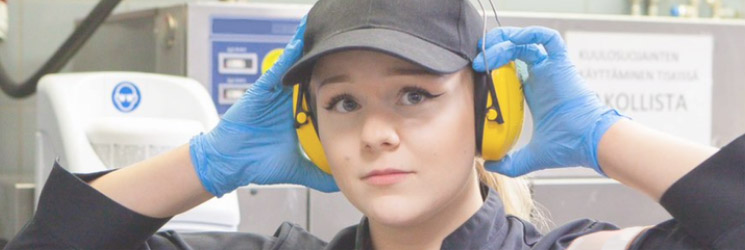

Working conditions
Workers who are pregnant, have recently given birth or are breastfeeding
The Pregnancy Protection Directive and the Pregnancy Protection Regulation do not precisely define what it means that a worker is pregnant, has recently given birth or is breastfeeding. In practice:
- A pregnant worker is a worker who is pregnant and has notified their employer of their pregnancy.
- A breastfeeding worker is a worker who is breastfeeding and has notified their employer of this.
- A worker who has recently given birth is a worker whose pregnancy leave has started no more than 14 weeks ago (chapter 4, section 2 of the Employment Contracts Act).
Hazardous agents
The use of the following substances or mixtures is known to pose a risk to pregnant or breastfeeding workers and to pregnancy or breastfeeding:
- chemical substances, mixtures and compounds belonging to one or more of the following hazard groups or categories and to which one or more of the following hazard statements apply:
- germ cell mutagenicity, category 1A, 1B or 2 (H340, H341)
- carcinogenicity, category 1A, 1B or 2 (H350, H350i, H351)
- reproductive toxicity, category 1A, 1B or 2 or additional category “effects on or via lactation” (H360, H360D, H360F, H360FD, H360Fd, H360Df, H361, H361d, H361f, H361fd, H362)
- specific target organ toxicity, single exposure, category 1 or 2 (H370, H371)
- other chemical agents, see below:
- inhalational anaesthetic agents
- mercury and mercury compounds
- carbon monoxide
- organic solvents
- cytostatic drugs
- oestrogens, progestins and other synthetic hormones and hormone antagonists
- manganese
- aluminium
- welding fumes
- environmental tobacco smoke
- chemical agents known to be hazardous and able to penetrate the skin
- working methods causing the risk of cancer listed in Annex I to Government Decree 113/2024. Read more in: risk of cancer.
Risk is also caused by biological, physical and physiological factors.
The following working conditions also pose a risk to workers who must be protected due to pregnancy or breastfeeding:
- underground mining work
- night work
- smoke and chemical diving
- scuba diving and working under high pressure
Employer’s responsibilities
The employer must investigate and identify factors causing hazards at work and assess their significance for the safety and health of workers who are pregnant, have recently given birth or are breastfeeding, as well as their significance for pregnancy and breastfeeding.
The employer must inform workers of the results of the risk assessment and the general measures to be taken at the workplace.
The employer must remind those exposed to hazardous agents in their work that it is important for them to notify the employer of their condition.
Upon receiving the information, the employer must, on the basis of the risk assessment, take measures to prevent and eliminate the worker’s exposure to hazards.
Individual measures
Once the employer has been made aware that a worker is pregnant, has recently given birth or is breastfeeding, the employer must initiate risk-assessment measures to prevent and eliminate the worker’s exposure to a particular hazard:
- The worker’s working conditions or working hours have to be temporarily adjusted so that the worker is not exposed to agents that pose a particular risk to their safety, health, pregnancy or breastfeeding.
- Where it is not technically feasible or reasonably possible to eliminate the risk by reducing exposure, there has to be an effort to transfer the worker to other suitable tasks. The worker’s professional skills and experience must be taken into account in the transfer.
- The employer has to strive to provide pregnant workers or workers who have recently given birth with the opportunity to transfer to day work if, according to a doctor’s statement, night work poses a risk to the worker’s safety, health or pregnancy. The statement can be issued by an occupational health care physician or some other physician who is familiar with the worker’s working conditions.
- The employer needs to be aware that the safety, health, pregnancy or breastfeeding of a pregnant or breastfeeding worker is always at risk in work where the worker is exposed to lead or lead compounds in a way that they can end up in the worker’s body.
- The employer needs to be aware that a pregnant worker’s safety, health and pregnancy are always at risk in work involving smoke or chemical diving, scuba diving or work under high pressure.
Special pregnancy leave
Special pregnancy allowance and subsequent special pregnancy leave can be granted if the work of a pregnant worker can endanger the health of the worker or the foetus and the employer cannot organise safe work. In addition, a prerequisite is that the pregnant person is able to work.
When an employee receives special pregnancy allowance, they cannot work for another employer. If the employer arranges other work that does not endanger the health of the pregnant person or the foetus, special pregnancy allowance is not paid.
Special pregnancy allowance can start immediately at the beginning of a pregnancy and continue at most until the worker becomes eligible for standard pregnancy allowance. The payment of special pregnancy allowance ends if the working conditions are made safe and the worker can return to work or if the employment relationship ends. Special pregnancy allowance is applied for from Kela.
Provisions regarding special pregnancy allowance are laid down in the Employment Contracts Act (55/2001) and in the Health Insurance Act (1224/2004).
Related topics in Tyosuojelu.fi:
Pregnancy and parental leave
Links to other websites:
Pregnancy allowance and special pregnancy allowance. Kela.

